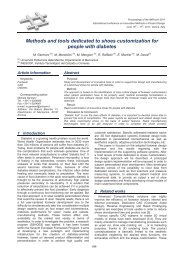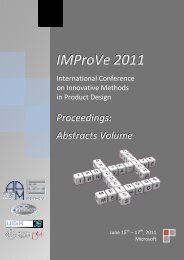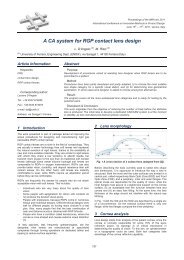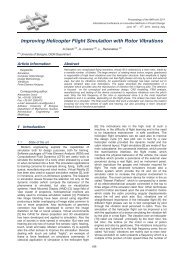IMProVe 2011 - Proceedings
IMProVe 2011 - Proceedings
IMProVe 2011 - Proceedings
You also want an ePaper? Increase the reach of your titles
YUMPU automatically turns print PDFs into web optimized ePapers that Google loves.
Surveying, Mapping and GIS Techniques<br />
Geometric processing of GeoEye-1 satellite imagery<br />
for coastal mapping applications<br />
M. Ángel Aguilar (a), F. J. Aguilar (a), A. Fernández (b), I. Fernández (a), M. del Mar Saldaña (a),<br />
A. M. García Lorca (c), J. G. Negreiros (d), A. Viciana (e), E. González (b)<br />
(a) Dept. of Agricultural Engineering, University of Almería, La Cañada de San Urbano, Spain<br />
(b) Dept. of Engineering Design, Universidad de Vigo, Escuela Técnica Superior de Ingeniería Industrial,<br />
Campus Universitario, Spain<br />
(c) Dept. Geography and History of the Art, University of Almería, La Cañada de San Urbano, Spain<br />
(d) ISEGI, Universidade Nova de Lisboa, Portugal<br />
(e) Dept. Geographical Regional Analysis, UNED, Universidad Nacional de Educación a Distancia<br />
Abstract:<br />
In 2008 and with the cooperation of the U.S. Department of Defence, it was launched a<br />
new commercial very high resolution (VHR) satellite named GeoEye-1 (GeoEye, Inc.)<br />
which, nowadays, is the commercial satellite with the best geometric resolution, so much<br />
in panchromatic (0.41m) as in multispectral (1.65m). More recently, on January 4, 2010,<br />
DigitalGlobe have begun to commercialize imagery of the last of the VHR satellites<br />
launched: WorldView-2. Its most relevant technical innovation includes the radiometric<br />
accuracy improvement, since the number of bands that compose its multispectral image<br />
has increased to 8, instead of the 4 classic bands (R, G, B, NIR) of the previous VHR<br />
satellites.<br />
These new VHR satellites offer important improvements closely related to spatial and<br />
spectral resolution. Therefore, an improvement is awaited in: (i) the geometric accuracies<br />
obtained in orthoimages and digital elevation models (DEMs) generated from scenes of<br />
GeoEye-1 and WorldView-2, as well as, (ii) an increase in the accuracy of the objects<br />
classification (urbanizations, buildings, highways, impervious zones, crops). These possible<br />
improvements will have to be contrasted with real tests carried out in field conditions,<br />
studying the ideal performance procedures in the seeking of accurate geo-referenced<br />
information.<br />
In this work the geometric accuracy of a single panchromatic image of GeoEye-1 with an<br />
off-nadir angle higher than 20 degrees was researched. Rational Polynomial Coefficients<br />
refined by a zero order polynomial adjustment (RPC0) was the sensor model that<br />
generated the best results. Using a DEM with a vertical accuracy of about 1.34 m, accurate<br />
orthoimages (planimetric root mean square error of 0.87 m) can be obtained from<br />
GeoEye-1 imagery.<br />
Keywords: Satellite imagery, Orthorectification, Classification, Accuracy, DEM.<br />
Corresponding Author: Manuel Ángel Aguilar<br />
Tel.: 950015950<br />
Fax.: 950015491<br />
e-mail: maguilar@ual.es<br />
June 15 th – 17 th , <strong>2011</strong>, Venice, Italy<br />
152<br />
<strong>IMProVe</strong> <strong>2011</strong> - <strong>Proceedings</strong>










